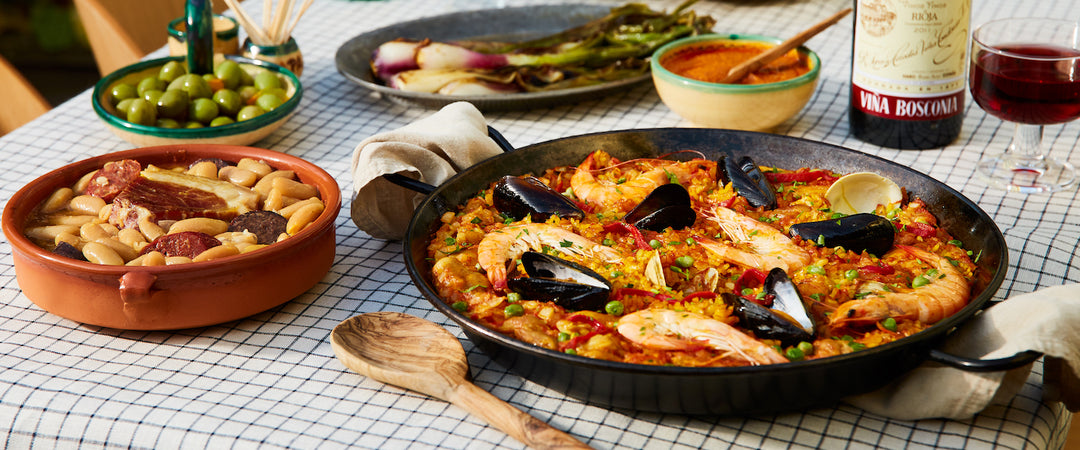Verdejo - The Best Kept Secret in White Wine
Friday June 14th is World Verdejo Day. The initiated know that it's Spain's best kept not-so-secret, since it's what's usually served when you simply order a "blanco" in Spain. The uninitated may ask "Ver-Day-who?". Let's dive in.
The Basics
Verdejo is mostly grown in the Rueda D.O. (part of Castilla Y Leon), where the tradition of wine making dates back to the 11th century. Verdejo makes light, bright-acid white wines with hints of grapefruit, lemon, and lime. Think Pinot Grigio and Sauvignon Blanc with a Spanish accent. The three most common styles are joven (young, fresh and fruity), sobre lias (aged sur-lie) with more depth, and barrel aged wines with both body and depth. Best of all, most Verdejos are affordably priced for that easygoing summer vibe.
Verde-Who? About The Grape
The Verdejo grape is thought to have originated in North Africa and brought to Spain by the Mozarabs in the 11th century. Until the middle of the 20th century, Verdejo was made into oxidized, sherry-like wines unlike the bright, fresh wines of today. In the mid 20th century, Verdejo almost became extinct, but was rescued by the efforts of a singular grape grower in the Rueda region: Angel Rodriguez Vidal. Read more about that story in our Customer Voice piece below.
The Perfect Wine For Cheese
Verdejo goes well with Spain’s Caña de Cabra and young Manchego cheeses. American cheeses like Cowgirl Creamery’s Mt. Tam, or locally-made brie-like cheese like Nicasio’s Locarno all pair well with Verdejo. We carry all of these cheeses in our San Francisco store and select (Manchego) in the other two stores.

Overlooked and Underpriced
Often, the best opinions about wine don't come from Spanish Table staff, but from our customers. Not too long ago, one of our customers (who wishes to remain anonymous), inquired about Belondrade Y Lurton, a sought after Spanish Verdejo. Staff at the Spanish Table found the older vintage he was searching for. In a follow up call, he shared his passion for white wines not commonly enjoyed in the US, and Verdejo in particular. Intrigued by his passion, we asked him to share his thoughts, which we have inlcluded below:
'I write this as a guy who makes wine professionally, and has been a passionate wine lover since the mid-1970s (yes, it means I’m f-ing old, and stay offa my lawn).
If you went into my cellar, you’d find a collection of the wines of the world, not the wines I make (‘Don’t get high on your own supply’ – Tony Montana in Scarface). Sure, you’d find plenty of wines from Burgundy, Bordeaux, Italy, the Rhone, Alsace, Germany, Austria and on and on, more than a few dating back to the early and mid-1900s. And yes, even a few new world wines that aren’t high octane blowsy caricatures of what wine can be.
But among all wines, I think it’s the Spanish wines I enjoy the most, and give the most incredible bang for the buck. To this day I don’t understand how beautiful well-made and age-worthy Riojas can sell for so little money, and to a lesser extent the wines of Ribera del Duero. But for all the love and attention the great Spanish reds rightfully enjoy, there is a Spanish white that remains the most overlooked and underpriced bargain in the world. In. The. World.
These are, of course, the Verdejos from the Rueda region of Spain. If you order “Vino Blanco” in much of Spain, you’re likely to get a wine made with, or largely with, Verdejo from Rueda. It’s perhaps the Spanish version of Sauv Blanc, but so much more interesting. Crisp, refreshing, and simply an incredibly versatile food wine. “Affordable” isn’t a pejorative wine term in this instance – it’s a bonus. You can quaff it like water on a hot day, or enjoy it in a more civilized fashion with damn near anything but red meat.
Verdejo has a long history- with production records dating it to the 11th century (Cabernet Sauvignon didn’t even arise until the 17th century - Carole Meredith confirmed this via DNA analysis). It’s a fighter too; it nearly became extinct, but the devotion of one man, Angel Rodriguez Vidal, pretty much saved it (who better than an ‘Angel’ to do that?!). In fact, King Juan Carlos 1 of Spain, a pretty cool dude in his own right, gave Angel the Order of The Cross for his efforts.
But here’s the real cool thing about the grape – beyond the “everyday” Verdejos, there are Verdejos that transcend anything you might think about Spanish whites. Wines made with an artisan approach, with the care and dignity reserved for the best grapes in the best places on earth and every bit as age worthy as any whites made any place on earth, but without the “premature oxidation” issues its special French neighbor to the north has experienced. Of course, the challenge is to hold them, but if you have that degree of patience, the rewards can be startling.
Drink it young, drink it aged, either way you can rightfully call yourself a genius, and your wife, husband, partner, lover, will gaze upon you with admiration. Plus, you can serve it blind to that guy who ‘knows everything’ about wine and watch him fumble around as he tries to tell you what it is, which is always entertaining. It really comes down to a question of whether you’re going to drink the same old- same old, or if you want to venture into something new, that happens to be crazy delicious. I think the choice is obvious.
Or maybe it’s just a question of whether or not you want to show some respect to my man Angel.'



